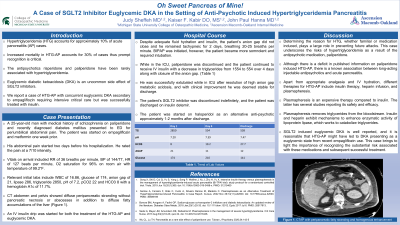Monday Poster Session
Category: Biliary/Pancreas
P1513 - “Oh Sweet Pancreas of Mine”: A Case of SGLT2 Inhibitor Euglycemic DKA in the Setting of Antipsychotic Induced Hypertriglyceridemia Causing Acute Pancreatitis
Monday, October 23, 2023
10:30 AM - 4:15 PM PT
Location: Exhibit Hall

Has Audio

Kaiser Kabir, DO, MS
Ascension Macomb Oakland
Warren, MI
Presenting Author(s)
Judy Sheffeh, MD1, Kaiser Kabir, DO, MS2, John Paul Hanna, MD1
1Ascension Macomb, Warren, MI; 2Ascension Macomb Oakland, Warren, MI
Introduction: Hypertriglyceridemia (HTG) accounts for approximately 10% of acute pancreatitis (AP) cases and is associated with increased mortality. Euglycemic diabetic ketoacidosis (eDKA) is a rare side effect of SGLT2 inhibitors. We report a case of paliperidone induced HTG, leading to AP with concurrent eDKA due to empagliflozin, successfully treated with insulin.
Case Description/Methods: A 25-year-old man with schizophrenia on paliperidone and recently diagnosed diabetes mellitus presented with 2 days of periumbilical abdominal pain, nausea and vomiting. The patient started empagliflozin and metformin one week ago. Labs include WBC 16.86, glucose 174, anion gap 21, lipase 286, TG 2850, pH of 7.2, pCO2 22 and HCO3 8 with hemoglobin A1c of 11.7%. CT abdomen showed diffuse peripancreatic stranding and fatty accumulations of the liver. Intravenous insulin infusion was started for both the treatment of the HTG-AP and eDKA. Despite adequate fluid hydration and insulin, the anion gap did not close. BIPAP was initiated due to persistent tachypnea, however, the patient became somnolent and required intubation. While in the ICU, paliperidone was discontinued and the patient continued to receive IV insulin, TG decreased from 1554 to 554 over 4 days and DKA resolved. The patient was discharged on a regimen of insulin, atorvastatin, fenofibrate and haloperidol.
Discussion: HTG-AP develops when TG levels are >1000. Mortality in HTG-AP accounts for 30% of cases thus prompt recognition is critical. Determining the etiology of HTG plays a large role in prevention. This case underscores the risks of HTG due to an antipsychotic. Although there is a deficit in published data on paliperidone-induced HTG-AP, there is a known association between long-acting injectable antipsychotics and acute pancreatitis. Therapies for HTG-AP include insulin therapy, heparin infusion, and plasmapheresis. HTG-AP may be an indication for plasmapheresis, which will facilitate the removal of TG. Plasmapheresis is an expensive therapy compared to insulin, which is effective and safe. Insulin and heparin enhance the enzymatic activity of lipoprotein lipase, which catabolizes TG. SGLT2-induced eDKA is well reported, and in our patient HTG-AP may have led to eDKA from recent empagliflozin use. This case brings to light the importance of recognizing the risk associated with these medications and its subsequent successful management in a critically ill patient.
Disclosures:
Judy Sheffeh, MD1, Kaiser Kabir, DO, MS2, John Paul Hanna, MD1. P1513 - “Oh Sweet Pancreas of Mine”: A Case of SGLT2 Inhibitor Euglycemic DKA in the Setting of Antipsychotic Induced Hypertriglyceridemia Causing Acute Pancreatitis, ACG 2023 Annual Scientific Meeting Abstracts. Vancouver, BC, Canada: American College of Gastroenterology.
1Ascension Macomb, Warren, MI; 2Ascension Macomb Oakland, Warren, MI
Introduction: Hypertriglyceridemia (HTG) accounts for approximately 10% of acute pancreatitis (AP) cases and is associated with increased mortality. Euglycemic diabetic ketoacidosis (eDKA) is a rare side effect of SGLT2 inhibitors. We report a case of paliperidone induced HTG, leading to AP with concurrent eDKA due to empagliflozin, successfully treated with insulin.
Case Description/Methods: A 25-year-old man with schizophrenia on paliperidone and recently diagnosed diabetes mellitus presented with 2 days of periumbilical abdominal pain, nausea and vomiting. The patient started empagliflozin and metformin one week ago. Labs include WBC 16.86, glucose 174, anion gap 21, lipase 286, TG 2850, pH of 7.2, pCO2 22 and HCO3 8 with hemoglobin A1c of 11.7%. CT abdomen showed diffuse peripancreatic stranding and fatty accumulations of the liver. Intravenous insulin infusion was started for both the treatment of the HTG-AP and eDKA. Despite adequate fluid hydration and insulin, the anion gap did not close. BIPAP was initiated due to persistent tachypnea, however, the patient became somnolent and required intubation. While in the ICU, paliperidone was discontinued and the patient continued to receive IV insulin, TG decreased from 1554 to 554 over 4 days and DKA resolved. The patient was discharged on a regimen of insulin, atorvastatin, fenofibrate and haloperidol.
Discussion: HTG-AP develops when TG levels are >1000. Mortality in HTG-AP accounts for 30% of cases thus prompt recognition is critical. Determining the etiology of HTG plays a large role in prevention. This case underscores the risks of HTG due to an antipsychotic. Although there is a deficit in published data on paliperidone-induced HTG-AP, there is a known association between long-acting injectable antipsychotics and acute pancreatitis. Therapies for HTG-AP include insulin therapy, heparin infusion, and plasmapheresis. HTG-AP may be an indication for plasmapheresis, which will facilitate the removal of TG. Plasmapheresis is an expensive therapy compared to insulin, which is effective and safe. Insulin and heparin enhance the enzymatic activity of lipoprotein lipase, which catabolizes TG. SGLT2-induced eDKA is well reported, and in our patient HTG-AP may have led to eDKA from recent empagliflozin use. This case brings to light the importance of recognizing the risk associated with these medications and its subsequent successful management in a critically ill patient.
Disclosures:
Judy Sheffeh indicated no relevant financial relationships.
Kaiser Kabir indicated no relevant financial relationships.
John Paul Hanna indicated no relevant financial relationships.
Judy Sheffeh, MD1, Kaiser Kabir, DO, MS2, John Paul Hanna, MD1. P1513 - “Oh Sweet Pancreas of Mine”: A Case of SGLT2 Inhibitor Euglycemic DKA in the Setting of Antipsychotic Induced Hypertriglyceridemia Causing Acute Pancreatitis, ACG 2023 Annual Scientific Meeting Abstracts. Vancouver, BC, Canada: American College of Gastroenterology.
